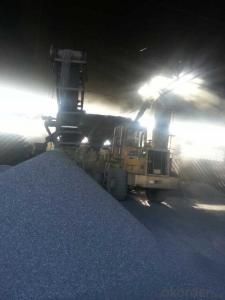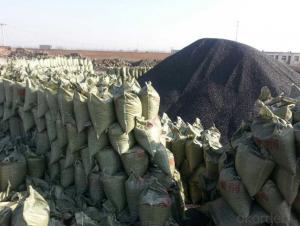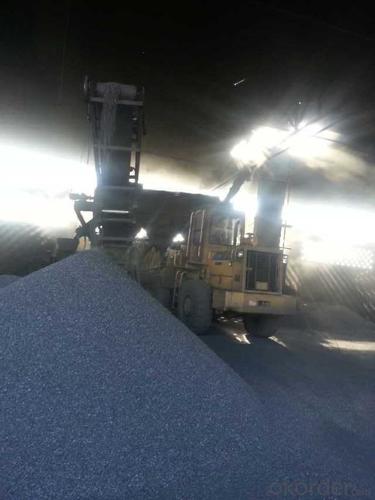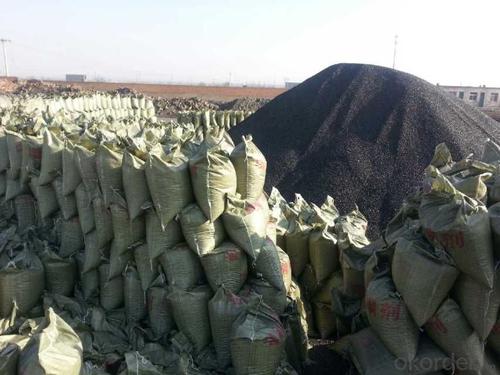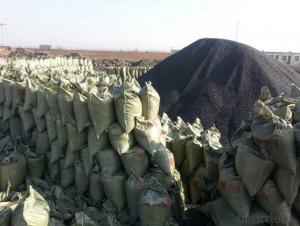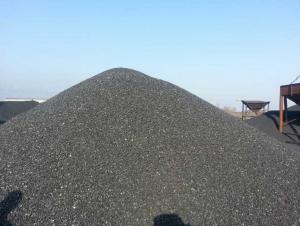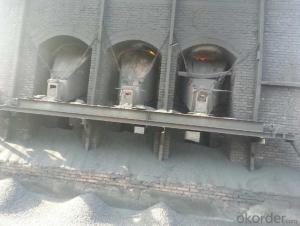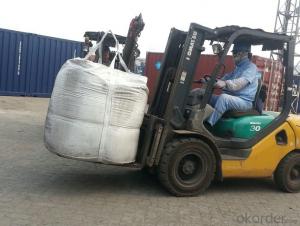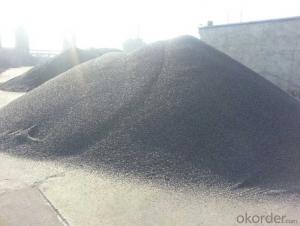Injection Coke FC85% min with stable quality
- Loading Port:
- Tianjin
- Payment Terms:
- TT OR LC
- Min Order Qty:
- 20 m.t.
- Supply Capability:
- 3000 m.t./month
OKorder Service Pledge
OKorder Financial Service
You Might Also Like
Packaging & Delivery
25kgs/50kgs/1ton per bag or as buyer's request
Specifications
Calcined Anthracite
Fixed carbon: 90%-95%
S: 0.5% max
Size: 0-3. 3-5.3-15 or as request
It used the high quality anthracite as raw materials through high temperature calcined at over 2000 by the DC electric calciner with results in eliminating the moisture and volatile matter from anthracite efficiently, improving the density and the electric conductivity and strengthening the mechanical strength and anti-oxidation. It has good characteristics with low ash, low resistvity, low sulphur, high carbon and high density. It is the best material for high quality carbon products.
Advantage and competitive of caclined anthracite:
1. strong supply capability
2. fast transportation
3. lower and reasonable price for your reference
4.low sulphur, low ash
5.fixed carbon:95% -90%
6..sulphur:lower than 0.3%
General Specification of Calcined Anthracite:
| FC | 80% | 83% | 85% | 88% | 90% |
| ASH % | 16 | 14 | 13 | 10 | 8.5 |
| V.M. % | 3 | 3 | 2 | 2 | 1.5 |
| S % | 0.5 | 0.5 | 0.5 | 0.5 | 0.35 |
| MOISTURE % | 2 | 2 | 1 | 1 | 0.5 |
Pictures
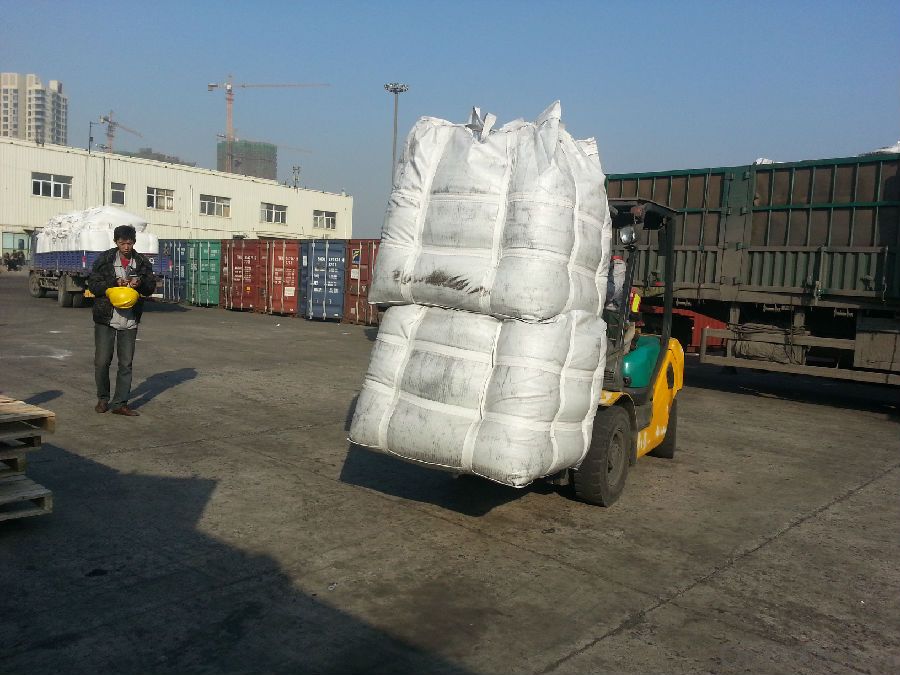
- Q: Why is carbon content of stainless steel low?
- This is because the main alloying elements of martensite chromium stainless steel is iron, chromium and carbon, such as Cr is greater than 13%, there is no gamma phase, such as single-phase alloy ferritic alloy, in any heat treatment system does not produce martensite, therefore must join the forming elements of austenite, Fe-Cr two alloy, to expand, C and N are effective elements, C, N elements adding alloy allows higher CR content. Chromium is one of the most important essential elements in martensitic chromium stainless steels, except chromium. In fact, martensitic chromium stainless steel is a kind of iron, chromium and carbon three element alloy C.However, the corrosion resistance of martensitic stainless steel mainly depends on the content of chromium, but the carbon in the steel due to the formation of stable chromium carbide with chromium, but also indirectly affect the corrosion resistance of steel. Therefore, in 13%Cr steel, the lower carbon content, the higher corrosion resistance. In 1Cr13, 2Cr13, 3Cr13 and 4Cr13 four kinds of steel, the corrosion resistance and strength of the order is just the opposite. In addition, carbon has an effect on the mechanical properties of stainless steel matrix.
- Q: What are the consequences of increased carbon emissions on coral reefs?
- Coral reefs are severely impacted by the increased emission of carbon, resulting in numerous consequences. One major effect is the occurrence of ocean acidification, which happens when excess carbon dioxide is absorbed by seawater, causing a decrease in pH levels. This acidification hampers the ability of corals to construct their calcium carbonate skeletons, making them more susceptible to erosion and breakage. Moreover, elevated levels of carbon dioxide in the atmosphere contribute to global warming, leading to the rise of ocean temperatures. Consequently, coral bleaching occurs as corals expel the symbiotic algae responsible for their vibrant colors. Without these algae, corals become stressed, lose their color, and become more vulnerable to disease and death. Additionally, increased carbon emissions contribute to alterations in ocean currents and weather patterns, resulting in more frequent and intense storms. These storms physically damage coral reefs, causing further destruction to already fragile ecosystems. The consequences of increased carbon emissions on coral reefs are profound and devastating. The decline of coral reefs not only impacts the biodiversity of the oceans but also has significant implications for human populations that rely on reefs for sustenance, income, coastal protection, and tourism. It is imperative to reduce carbon emissions and take immediate action to safeguard and preserve these invaluable ecosystems.
- Q: What are the impacts of carbon emissions on the stability of coastal areas?
- Carbon emissions have significant impacts on the stability of coastal areas, posing various challenges to the environment and communities residing in these regions. One of the most prominent impacts is sea-level rise, caused by the melting of polar ice caps and thermal expansion of seawater due to rising global temperatures. As carbon dioxide and other greenhouse gases accumulate in the atmosphere, they trap heat, leading to the warming of the planet. This, in turn, causes glaciers and ice sheets to melt, contributing to the rising sea levels. Sea-level rise poses a direct threat to coastal areas, resulting in increased erosion, coastal flooding, and the loss of valuable land. As water levels rise, the shoreline retreats, eroding beaches and cliffs, and endangering coastal infrastructure and habitats. This erosion not only threatens the stability of coastal ecosystems but also puts human settlements at risk, leading to the displacement of communities and loss of property. Moreover, the increase in carbon emissions leads to ocean acidification, whereby the excess carbon dioxide is absorbed by the ocean, resulting in a decrease in its pH levels. Acidic waters have detrimental effects on marine life, including coral reefs, shellfish, and other marine organisms that rely on calcium carbonate for their shells and skeletons. As the acidity of the ocean increases, these organisms struggle to form and maintain their protective structures, leading to the degradation of coastal ecosystems and the loss of biodiversity. Another impact of carbon emissions on coastal areas is the intensification of extreme weather events, such as hurricanes and tropical storms. Warmer ocean temperatures provide more energy for these storms, making them more powerful and destructive. These events can cause extensive damage to coastal infrastructure, including buildings, roads, and utility systems. Furthermore, they can result in the loss of lives and livelihoods, exacerbating the vulnerability of coastal communities. In summary, carbon emissions have far-reaching impacts on the stability of coastal areas. Sea-level rise, ocean acidification, and intensified extreme weather events all contribute to the degradation of coastal ecosystems, loss of biodiversity, erosion, and coastal flooding. These impacts not only threaten the environment but also pose significant risks to human settlements, requiring urgent mitigation and adaptation measures to protect coastal areas and the communities that rely on them.
- Q: What are the properties of carbon-based textiles?
- Carbon-based textiles offer several distinct advantages in different applications. To begin with, they demonstrate exceptional strength and durability. Renowned for their high tensile strength, carbon-based textiles can resist stretching and tearing, enabling them to withstand harsh conditions and maintain their integrity over time. Moreover, these textiles possess excellent thermal conductivity, efficiently managing heat. This quality proves beneficial in industries like aerospace, automotive, and electronics, where effective heat dissipation is crucial to prevent system failures. Additionally, carbon textiles exhibit remarkable resistance to chemical corrosion, remaining structurally intact even when exposed to various chemicals, acids, and solvents. This resistance makes them ideal for applications in the chemical industry, where contact with corrosive substances is common. Another notable attribute of carbon textiles is their inherent flame resistance. They possess a high resistance to ignition and do not easily propagate flames. Consequently, they find use in environments where fire safety is paramount, such as protective clothing for firefighters and military personnel. Furthermore, carbon-based textiles display good electrical conductivity, making them suitable for electronics and electrical engineering applications. They effectively conduct electricity and dissipate static charges, reducing the risk of electrical malfunctions or damage. Lastly, carbon textiles have a low coefficient of thermal expansion, meaning they undergo minimal expansion or contraction with temperature changes. This property ensures their dimensional stability, guaranteeing that they maintain their shape and size under varying thermal conditions. In conclusion, carbon-based textiles possess a combination of strength, durability, thermal conductivity, chemical resistance, flame resistance, electrical conductivity, and dimensional stability. These properties render them highly versatile and suitable for a wide range of applications across various industries.
- Q: What is carbon neutral manufacturing?
- Carbon neutral manufacturing refers to the practice of minimizing and offsetting greenhouse gas emissions produced during the manufacturing process. It involves implementing sustainable measures, using renewable energy sources, and investing in carbon offset projects to balance out the emissions released. This approach aims to achieve a net-zero carbon footprint, where the amount of carbon dioxide emitted is equal to the amount removed from the atmosphere, thus mitigating climate change impacts associated with manufacturing activities.
- Q: What is the composition of carbon in stainless steel?
- Adjust the hardness, general carbon content, the higher the relative hardness is relatively hard. But no, the higher the better, the carbon content needs to be well controlled. For example, if the welding position is too high carbon, it will lead to brittle weld and easy to crack.
- Q: How does carbon impact the prevalence of cyclones?
- Carbon emissions and the subsequent increase in atmospheric carbon dioxide levels have a significant impact on the prevalence of cyclones. Cyclones, also known as hurricanes or typhoons, are powerful and destructive weather phenomena that form over warm ocean waters. The increased carbon in the atmosphere, primarily due to human activities such as burning fossil fuels, leads to global warming and alters the climate patterns. Warmer ocean temperatures caused by carbon emissions provide the necessary fuel for cyclones to form and intensify. As carbon dioxide traps heat in the atmosphere, it warms the surface of the oceans, creating a favorable environment for cyclone development. The warmer the ocean waters, the more energy is available for cyclones to grow and become more destructive. Additionally, carbon emissions contribute to the changing climate patterns, leading to shifts in atmospheric circulation patterns. These changes can influence the frequency, intensity, and track of cyclones. While it is difficult to attribute individual cyclones to carbon emissions, scientific studies show that the overall increase in carbon dioxide levels is contributing to a greater number of severe cyclones in certain regions. Furthermore, the rising sea levels associated with global warming and carbon emissions can exacerbate the impact of cyclones. Higher sea levels lead to increased storm surge, which is the abnormal rise in water level during a cyclone. This storm surge can cause devastating flooding in coastal areas and result in significant damage to infrastructure and loss of life. In conclusion, carbon emissions have a profound impact on the prevalence of cyclones. The increased atmospheric carbon dioxide levels contribute to warmer ocean temperatures, creating a more favorable environment for cyclone formation and intensification. Changes in climate patterns due to carbon emissions also affect the frequency and track of cyclones. Additionally, rising sea levels associated with global warming can worsen the impact of cyclones through increased storm surge. It is crucial for society to address carbon emissions and work towards sustainable solutions to mitigate the impacts of cyclones and other severe weather events.
- Q: How does carbon impact the prevalence of floods?
- Carbon does not directly impact the prevalence of floods, but it does play a significant role in influencing climate change, which in turn can affect the occurrence and severity of floods. Carbon dioxide (CO2) is a greenhouse gas that is primarily responsible for trapping heat in the Earth's atmosphere, leading to a phenomenon known as global warming. This rise in global temperatures has several consequences, one of which is an increase in the frequency and intensity of extreme weather events, including floods. As the planet warms, the atmosphere is able to hold more moisture, resulting in an increased likelihood of heavy precipitation events. This can lead to more intense rainfall, causing rivers and other water bodies to overflow their banks and resulting in flooding. Additionally, warmer temperatures can also cause glaciers and ice caps to melt, contributing to rising sea levels, which can exacerbate the impacts of flood events, particularly in coastal regions. Furthermore, carbon emissions from human activities such as burning fossil fuels and deforestation are the primary drivers of climate change. By reducing our carbon footprint and transitioning to cleaner sources of energy, we can help mitigate the impacts of climate change and potentially reduce the prevalence of floods in the long term. It is important to note that while carbon emissions are a significant factor in climate change, they are not the sole cause of floods. Other natural factors such as rainfall patterns, topography, and land use also play important roles in determining flood risks.
- Q: What are the applications of carbon nanowires?
- Due to their unique properties and characteristics, carbon nanowires find wide-ranging applications across various fields. Some of the main uses of carbon nanowires include: 1. Electronics: Carbon nanowires serve as conducting channels in electronic devices like transistors and interconnects. Their small size, high electrical conductivity, and ability to handle high current densities make them ideal for nanoelectronics. 2. Energy storage: Carbon nanowires prove useful in energy storage devices such as batteries and supercapacitors. Their excellent electrical conductivity and high surface area enable efficient charge and energy storage, leading to enhanced performance and longer lifespan. 3. Sensors: Carbon nanowires function as sensing elements in different types of sensors. Their high sensitivity to temperature, pressure, or gas concentration changes makes them suitable for applications in environmental monitoring, healthcare, and industrial sensing. 4. Biomedical applications: Carbon nanowires hold promise in biomedical applications, including drug delivery systems and tissue engineering. They can be modified with specific molecules to target and deliver drugs to particular cells or tissues. Additionally, their biocompatibility and high mechanical strength make them suitable for scaffolds in tissue engineering. 5. Nanoelectromechanical systems (NEMS): Carbon nanowires contribute to the construction of NEMS devices, which are miniature mechanical systems operating at the nanoscale. These devices find applications in sensing, actuation, and data storage, and carbon nanowires possess the necessary mechanical and electrical properties for their operation. 6. Nanocomposites: Carbon nanowires are capable of enhancing the mechanical, electrical, and thermal properties of various materials. They can reinforce polymers, ceramics, and metals, resulting in improved strength, conductivity, and heat dissipation in the resulting nanocomposites. 7. Optoelectronics: Carbon nanowires find utility in optoelectronic devices like photodetectors and light-emitting diodes (LEDs). Their ability to emit light, low electrical resistance, and high electron mobility make them suitable for applications in displays, lighting, and optical communications. In conclusion, the applications of carbon nanowires are diverse and expanding, with the potential to revolutionize fields such as electronics, energy storage, sensing, biomedicine, and more. Ongoing research and development in this field are expected to uncover even more exciting applications in the future.
- Q: What are the main factors that affect the strength of carbon fibers?
- [Abstract]: the interface play on the properties of carbon fiber composite material plays a very important role, the composite load transfer through the interface, can make the carbon fiber and the matrix to form an effective performance of the whole. In the study of the interface, improving the bonding strength is the key to improve the mechanical properties of the carbon fiber composite. Therefore, it is very important to analyze the influence of various factors on the interfacial bonding strength of carbon fiber reinforced composites for improving the comprehensive properties of composites. In this paper, by using scanning electron microscopy (SEM), X ray photoelectron spectroscopy (XPS), laser Raman spectroscopy (LRS), X ray diffraction (XRD) and Fu Liye transform infrared spectroscopy (FTIR) and mechanical testing technology, investigated the effect of different preparation processes on the structure and properties of carbon fiber, discusses the evolution of the structure and properties of the carbon fiber surface process and electrochemical treatment in the process of electrochemical modification prepared by wet spinning PAN based carbon fiber, the carbon fiber surface except the rationality of glue craft, in-depth study of the carbon fiber electrochemical treatment, sizing agent and matrix modification effect on the bonding strength of carbon fiber composite the carbon fiber material, electrochemical modification mechanism and matrix modification mechanism.
Send your message to us
Injection Coke FC85% min with stable quality
- Loading Port:
- Tianjin
- Payment Terms:
- TT OR LC
- Min Order Qty:
- 20 m.t.
- Supply Capability:
- 3000 m.t./month
OKorder Service Pledge
OKorder Financial Service
Similar products
Hot products
Hot Searches
Related keywords
